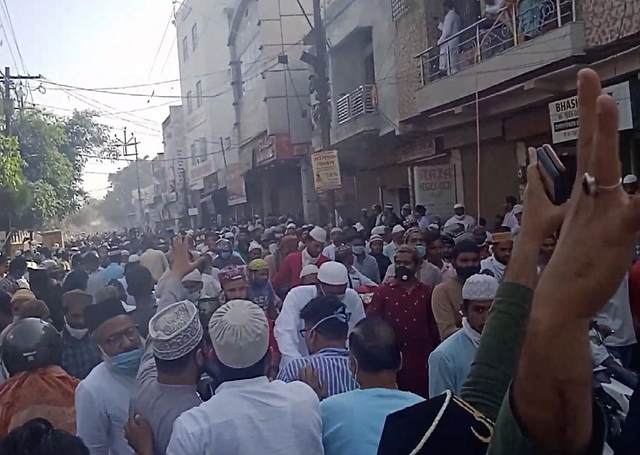
Bareilly Saw A Massive Rally With ‘Sar Tan Se Juda’ Slogans Last Week. Both Media And Police Downplayed It
The rally, on Friday, saw participation of thousands of people who rallied across the city.
What happened recently in Bareilly, stayed in Bareilly, but it needs to reach far and wide. A dark chapter of history is repeating.
On Friday, thousands of residents in and around Uttar Pradesh’s Bareilly city gathered in the streets and took out a protest march against ‘blasphemy’.
The target of their protest was Yati Narsinghanand Saraswati, priest at a private temple in Dasna area of Ghaziabad district and self-proclaimed Hindutva activist.
Narsinghanand recently made statements against Prophet Mohammed at an event held at Delhi Press Club, the video of which was widely circulated on social media.
You can see visuals of the Bareilly rally in tweets below:
As visible, the participation ran into thousands if not lakhs. No Covid-related precautions such as masks or social distancing were followed.
Slogans of “Gustakh-E-Rasool ki ek hi saza, sar tan se juda, sar tan se juda” [There is only one punishment for speaking against the Prophet and that is beheading] were raised repeatedly.
The protest in Bareilly was ignored by the national English media. It was given subdued coverage even in the Hindi press. The protest was downplayed and the inciteful slogans raised at the protest march did not make it to reports at all.
Hindi daily Amar Ujala, which covered the event in more detail than others, said in its report that the city magistrate of Bareilly requested the protesters to hand over their memorandum of demand outside Jama Masjid itself. However, the protesters did not agree.
The crowd of thousands of people rallies across the city for more than 30 minutes before handing the memorandum to additional district magistrate Ram Sevak Dwivedi. The protesters have demanded that Narsinghanand be booked under the National Security Act (NSA).
The report further said that a maulana in another district of UP, Pilibhit, was thrashed by members of his community after he tried to cancel a proposed march. The crowd tore off his clothes, as per the report, which made no mention of “sar tan se juda” slogans.
It’s pertinent to mention here that Kamlesh Tiwari, a UP resident accused of blasphemy in 2015 after he circulated pamphlets criticising Prophet Mohammed, was booked under the NSA by the erstwhile Akhilesh Yadav government in Uttar Pradesh.
However, the Supreme Court in October 2016 – that is, nearly a year after his arrest –quashed Tiwari’s detention under NSA. Tiwari was later killed by fanatics in 2019 at his office.
His murder was preceded by similar protest marches and slogans as are now being seen in the case of Narsinghanand, who has already had a first information report (FIR) filed against him at a police station in New Delhi.
The complaint was given by Aam Aadmi Party Amanatullah Khan, who earlier tweeted that Narsinghanand’s head and tongue should be chopped off. Khan’s post was taken down by Twitter after outrage.
ABP Ganga reported the Bareilly protest with concerns about the spread of coronavirus. The report said that the participants rallied across the city of Bareilly before finally gathering at the Islamia ground. The report made no mention of the beheading slogans.
Hindi daily Dainik Jagran, unlike Amar Ujala, repeatedly raised Covid-related concerns due to the rally. The report said that the protest was carried out on the call of an organisation named Jamaat Raza-E-Mustafa, and announcements were made through loudspeakers at mosques on the previous night itself.
The report said that many participants came from other districts such as Agra, Badaun, Pilibhit and Kasganj.
The Dainik Jagran report, again, made no mention of the “sar tan se juda” slogans and simply said that the protesters vowed they would not tolerate insults against the Prophet.
As it turned out, the Bareilly police too downplayed the numbers and inflammatory slogans raised at the march.
Response to a video posted by this correspondent on Twitter, the verified account of Bareilly police attached a press note.
It said that the protest march was organised by an organisation in response to a statement made by a man (Narsinghanand) and the protesters handed over a memorandum of demands to the city authorities, which dismissed the march after accepting it.
The press statement was criticised by several Twitter users, who asked why the police made no mention of the “sar tan se juda” slogans and if they were acceptable to them.
The reality of the Bareilly rally would not have reached the public if it were not for the social media.
Visuals of the rally that have emerged raised serious questions on its handling by the city and state authorities. Should the rally have been allowed given the so-called second wave of Covid-19 pandemic?
The adjoining state of Uttarakhand is already under fire for allowing the Kumbh at Haridwar where sadhus and devotees in lakhs have gathered to take a dip in the sacred waters of the Ganga river, even though preparations for the Kumbh had begun much before the alarm of the second wave.
Crowds are also being allowed across the country for religious events such as Ramzan and Baisakhi as is evident from pictures of mosques and gurudwaras.
However, the protest march could have been disallowed if the aim of the protesters was only handing over their memorandum of demands to the authorities.
Unfortunately, not only was the crowd allowed to roam across the city for which a bunch of representatives giving their demands in written could have sufficed, but the inflammatory demands of application of Shariat law for crimes covered under the Indian Penal Code were also allowed to be raised.